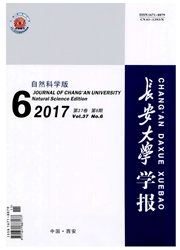

 中文摘要:
中文摘要:
应用700份调研样本数据,分析了城市低收入人群的年龄分布与就业状况。结合非集计模型理论,分析了影响低收入人群出行方式选择的因素。将驾驶人个人属性、家庭属性、车辆属性与出行属性作为效用变量,将步行、自行车、公交车3种交通方式作为低收入人群出行方式选择肢,构建了城市低收入人群出行方式选择模型,并确定了模型中相应的变量与取值方法。另选取175份调研数据,对模型的准确性进行验证。计算结果表明:应用建立的模型,步行、自行车、公交车3种交通方式的计算结果分别为23.4%、25.7%、50.9%;在调研数据中,3种交通方式的结果分别为21.7%、24.6%、53.7%;计算值与统计值的绝对误差较小,最大误差仅为2.8%。
 英文摘要:
英文摘要:
The 700 investigation sample data were used to analyze the age distribution and employ- ment situation of urban low-income population. Based on the theory of disaggregate model, the influence factors of travel mode for urban low-income population was analyzed. The individual attribute of driver, family attribute, vehicle attribute and travel attribute were taken as utility variables, the three traffic modes such as walking, bicycle and bus were taken as the alternative parts of travel modes for low-income population, the selection model of travel mode for urban low-in- come population was set up, and the corresponding variables and obtaining value method were de- termined. According to the other 175 investigation sample datum, the accuracy of proposed model was verified. Calculation results show that by using the proposed model, the calculation result proportions of those three traffic modes such as walking, bicycle and bus are 23.4%, 25.7% and 50.9% respectively. While in the investigation sample datum, the results of those three travel modes are 21.7%, 24.6% and 53.7% respectively. The absolute errors between calculation values and statistical values are smaller, and the maximum error value is only 2.80/00. 5 tabs, 3 figs, 13 refs.
 同期刊论文项目
同期刊论文项目
 同项目期刊论文
同项目期刊论文
 期刊信息
期刊信息
